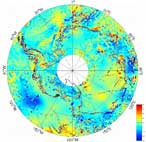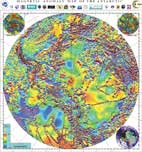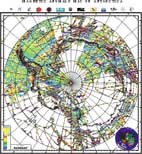Publications from the ADMAP group from 2008 to 2016 are listed below. Details of publications by the ADMAP group from before 2008 are listed on
the ADMAP website.
2016
F. J. Davey, R Granot, S. C. Cande, J. M. Stock, M. Selvans, F. Ferraccioli, 2016. Synchronous Oceanic Spreading and Continental Rifting in West Antarctica. Geophysical Research Letters, DOI: 10.1002/2016GL069087.
A. R. A. Aitken,J. L. Roberts, T. D. van Ommen,D. A. Young, N. R. Golledge, J. S. Greenbaum, D. D. Blankenship & M. J. Siegert, 2016. Repeated large-scale retreat and advance of Totten Glacier indicated by inland bed erosion. Nature 533,385-389, doi:10.1038/nature17447
A.R.A. Aitken, P.G. Betts, D.A. Young, D.D. Blankenship, J.L. Roberts, M.J. Siegert, 2016. The Australo-Antarctic Columbia to Gondwana transition. Gondwana Research, 29 (1), 136-152, doi:10.1016/j.gr.2014.10.019.
Frederick, B. C., Young, D. A., Blankenship, D. D., Richter, T. G., Kempf, S. D., Ferraccioli, F., and Siegert, M. J.,2016, Distribution of subglacial sediments across the Wilkes Subglacial Basin, East Antarctica, Journal Of Geophysical Research: Earth Surface, 121, 4, 790–813, 10.1002/2015JF003760
2015
Ferraccioli F., 2015. Antarctic Frontiers as revealed from a decade of aerogeophysical exploration. First Break, European Association of Geoscientists & Engineers, doi: 10.3997/2214-4609.201411994.
Greenbaum, J. S., Blankenship, D. D., Young, D. A., Richter, T. G., Roberts, J. L., Aitken, A. R. A., Legresy, B., Schroeder, D. M., Warner, R. C., van Ommen, T. D., and Siegert, M. J.,2015, Ocean access to a cavity beneath Totten Glacier in East Antarctica, Nature Geosciences, 8, 294-298, 10.1038/ngeo2388
DYMENT, J., et al. Global equivalent magnetization of the oceanic lithosphere. Earth and Planetary Science Letters, 2015, 430: 54-65.
JACOBS, J., ELBURG, M., LÄUFER, A., KKLEINHANNS, I.C.,HENJES-KUNST, F., ESTRADA, S., RUPPEL, A.S., DAMASKE, MONTERO, P. & BEA, F. (2015): Two distinct Late Mesoproterozoic/Early Neoproterozoic basement provinces in central/eastern Dronning Maud Land, East Antarctica: The missing link, 15–21◦E – . – Precambrian Research, 265, 249-272, http://dx.doi.org/10.1016/j.precamres.2015.05.003.
2014
DAMASKE, D., SCHRECKENBERGER, B. & GOLDMANN, F. (2014): A High Resolution Aeromagnetic Survey over the Mesa Range, northern Victoria Land, Antarctica. – Polarforschung, 84, (1), 1-13.
JORDAN, T. A., et al. Structure and evolution of Cenozoic arc magmatism on the Antarctic Peninsula: a high resolution aeromagnetic perspective. Geophysical Journal International, 2014, 198.3: 1758-1774.
Eagles, G., and Jokat, W., 2014, Tectonic reconstructions for paleobathymetry in Drake Passage, Tectonophyiscs, 611, 28-50. Doi:10.1016/j.tecto.2013.11.021.
MIETH, M., JACOBS, J., RUPPEL, A., DAMASKE, D., LÄUFER, A. & JOKAT, W. (2014): New detailed aeromagnetic and geological data of eastern Dronning Maud Land: Implications for refining the tectonic and structural framework of Sør Rondane, East Antarctica. – Precambrian Research, 245, 174-185, doi:10.1016/j.precamres.2014.02.009.
Mieth, M., and Jokat, W., 2014, New aeromagnetic view of the geological fabric of southern Dronning Maud Land and Coats Land, East Antarctica, Gondwana Research, 25, 358-367. Doi:10.1016/j.gr.2013.04.003
Mieth, M. and Jokat, W. (2014): Banded iron formation (?) at Grunehogna Craton, East Antarctica – constraints from aeromagnetic data , Precambrian Research, 250 , pp. 143- 150 . doi: 10.1016/j.precamres.2014.06.001
CATALÁN, Manuel, et al. Monitoring the evolution of Deception Island volcano from magnetic anomaly data (South Shetland Islands, Antarctica). Global and Planetary Change, 2014, 123: 199-212.
PANDIT, Manoj K.; DE WALL, Helga. Preliminary Magnetic Susceptibility Characteristics of the Bharati Promontory (Grovness Peninsula), Larsemann Hills, Prydz Bay Region, East Antarctica. Journal of the Geological Society of India, 2014, 84.2: 163-173.
Aitken, A. R. A., D. A. Young, F. Ferraccioli, P. G. Betts, J. S. Greenbaum, T. G. Richter, J. L. Roberts, D. D. Blankenship, and M. J. Siegert (2014), The subglacial geology of Wilkes Land, East Antarctica, Geophys. Res. Lett., 41, 2390-2400, doi:10.1002/2014GL059405.
T.M.Damiani, T.A.Jordan, F.Ferraccioli, D.A.Young, D.D.Blankenship, 2014. Variable crustal thickness beneath Thwaites Glacier revealed from airborne gravimetry, possible implications for geothermal heat flux inWest Antarctica. Earth and Planetary Science Letters 407, 109–122.
2013
Ferraccioli, F., Ralph von Frese, Marta Ghidella, 2013 (Guest Editors). Recent advances in Antarctic Geomagnetism and Lithosphere studies. Tectonophysics, 585, 1-2, 10.1016/j.tecto.2012.11.002.
Gohl, K., Denk, A., Eagles, G., and Wobbe, F., 2013, Deciphering tectonic phases of the Amundsen Sea Embayment shelf, West Antarctica, from a magnetic anomaly grid, Tectonophysics, 585, 113-123. Doi:10.1016/j.tecto.2012.06.036.
Golynsky, A., Bell, R., Blankenship, D., Damaske, D., Ferraccioli, F., Finn, C., Golynsky, D., Ivanov, S., Jokat, W., Masolov, V., Riedel, S., von Frese, R, Young, D. and the ADMAP Working Group (2013). Air and shipborne magnetic surveys of the Antarctic into the 21st century. Tectonophysics, Recent advances in Antarctic geomagnetism and lithosphere studies, 585, 3–12, doi:10.1016/j.tecto.2012.02.017
Tozzi, R., De Santis, A., & Gaya-Piqué, L. R. (2013). Antarctic geomagnetic reference model updated to 2010 and provisionally to 2012. Tectonophysics, Recent advances in Antarctic geomagnetism and lithosphere studies, 585, 13-25.
H.R. Kim and R.R.B. von Frese (2013). Localized analysis of polar geomagnetic jerks. Tectonophysics, Recent advances in Antarctic geomagnetism and lithosphere studies, 585, 26–33.
J.W. Kim, H.R. Kim, R. von Frese, P. Taylor and E. Rangelova (2013). Geopotential field anomaly continuation with multi-altitude observations. Tectonophysics, Recent advances in Antarctic geomagnetism and lithosphere studies, 585, 34–47.
A.S. Wendt, A.P.M. Vaughan, F. Ferraccioli and A.M. Grunow (2013). Magnetic susceptibilities of rocks of the Antarctic Peninsula: Implications for the redox state of the batholith and the extent of metamorphic zones. Tectonophysics, Recent advances in Antarctic geomagnetism and lithosphere studies, 585, 48–67.
J. Galindo-Zaldívar, A. Ruiz-Constán, A. Pedrera, M. Ghidella, M. Montes, F. Nozal and L.R. Rodríguez-Fernandez (2013). Magnetic anomalies in Bahia Esperanza: A window of magmatic arc intrusions and glacier erosion over the northeastern Antarctic Peninsula. Tectonophysics, Recent advances in Antarctic geomagnetism and lithosphere studies, 585, 68–76.
T. Yegorova and V. Bakhmutov (2013). Crustal structure of the Antarctic Peninsula sector of the Gondwana margin around Anvers Island from geophysical data. Tectonophysics, Recent advances in Antarctic geomagnetism and lithosphere studies, 585, 77–89.
Ghidella, M. E., Zambrano, O. M., Ferraccioli, F., Lirio, J. M., Zakrajsek, A. F., Ferris, J., & Jordan, T. A. (2013). Analysis of James Ross Island volcanic complex and sedimentary basin based on high-resolution aeromagnetic data. Tectonophysics, Recent advances in Antarctic geomagnetism and lithosphere studies, 585, 90-101.
M. Catalán, J. Galindo-Zaldivar, J.M. Davila, Y.M. Martos, A. Maldonado, L. Gambôa and A.A. Schreider (2013). Initial stages of oceanic spreading in the Bransfield Rift from magnetic and gravity data analysis. Tectonophysics, Recent advances in Antarctic geomagnetism and lithosphere studies, 585, 102–112.
K. Gohl, A. Denk, G. Eagles and F. Wobbe (2013) Deciphering tectonic phases of the Amundsen Sea Embayment shelf, West Antarctica, from a magnetic anomaly grid, Tectonophysics, Recent advances in Antarctic geomagnetism and lithosphere studies, 585, 113-123.
Behrendt, J. C. (2013) The aeromagnetic method as a tool to identify Cenozoic
magmatism in the West Antarctic Rift System beneath the West Antarctic Ice Sheet — A review; Thiel subglacial volcano as possible source of the ash layer in the WAISCORE, Tectonophysics, Recent advances in Antarctic geomagnetism and lithosphere studies, 585, 124-136.
Jordan, T. A., Ferraccioli, F., Ross, N., Corr, H. F., Leat, P. T., Bingham, R. G., & Siegert, M. J. (2013). Inland extent of the Weddell Sea Rift imaged by new aerogeophysical data. Tectonophysics, Recent advances in Antarctic geomagnetism and lithosphere studies, 585, 137-160.
Riedel, S., Jacobs, J., and Jokat, W., 2013, Interpretation of new regional aeromagnetic data over Dronning Maud Land (East Antarctica), Tectonophysics, Recent advances in Antarctic geomagnetism and lithosphere studies, 585, 161-171. Doi:10.1016/j.tecto.2012.10.011
Golynsky, A.V., Ivanov, S.V., Kazankov, A.Ju., Jokat, W., Masolov, V.N., von Frese, R.R.B. and the ADMAP Working Group (2013). New continental margin magnetic anomalies of East Antarctica. Tectonophysics, Recent advances in Antarctic geomagnetism and lithosphere studies, Vol. 585. 172–184, doi:10.1016/j.tecto.2012.06.043
von Frese, R.R.B, Kim, H.R., Leftwich, T.E. , Kim, J.W. and Golynsky, A.V. (2013). Satellite magnetic anomalies of the Wilkes Land impact basin inferred from regional gravity and terrain data. Tectonophysics, Recent advances in Antarctic geomagnetism and lithosphere studies, 585, 185–195. doi:10.1016/j.tecto.2012.09.009
T.A. Jordan, F. Ferraccioli, E. Armadillo and E. Bozzo (2013). Crustal architecture of the Wilkes Subglacial Basin in East Antarctica, as revealed from airborne gravity data. Tectonophysics, Recent advances in Antarctic geomagnetism and lithosphere studies, 585, 196–206.
Osanai, Y., Nogi, Y., Baba, S., Nakano, N., Adachi, T., Hokada, T., Toyoshima, T., Owada, M., Satish-Kumar, M., Kamei, A. & Kitano, I. (2013). Geologic evolution of the Sør Rondane Mountains, East Antarctica: Collision tectonics proposed based on metamorphic processes and magnetic anomalies. Precambrian Research, 234, 8-29.
YANG, Y., DENG, X. G., & REN, J. B. (2013). Characteristic of gravity and magnetic and regional tectonics of Antarctica and its adjacent sea. Progress in Geophysics, 2, 057.
Nogi, Y., Jokat, W., Kitada, K., & Steinhage, D. (2013). Geological structures inferred from airborne geophysical surveys around Lützow-Holm Bay, East Antarctica. Precambrian Research, 234, 279-287
2012
Bingham, R.G., Ferraccioli, F., King, E.C., Larter, R.D., Pritchard, H.D., Smith, A.M. & Vaughan, D.G., 2012. Inland thinning of West Antarctic Ice Sheet steered along subglacial rifts. Nature, 487, 468-471. DOI: 10.1038/nature11292.
Golynsky, D.A., Golynsky, A.V. (2012). East Antarctic Rift Systems – key to understanding of Gondwana break-up. Regional geology and metallogeny. St.-Petersburg, VSEGEI, (In Russian), No52, 58-72.
Leinweber, V.T., and Jokat, W., 2012, The Jurassic history of the Africa-Antarctica corridor – new constraints from magnetic data on the conjugate continental margins, Tectonophysics, 530-531, 87-101. Doi:10.1016/j.tecto.2011.11.008
Riedel, S., Jokat, W., and Steinhage, D., 2012, Mapping tectonic provinces with airborne gravity and radar data in Dronning Maud Land, East Antarctica, Geophys. J. Int., 189, 414-427. Doi:10.1111/j.1365-246X.2012.05363.x
2011
LÄUFER, A.L., DAMASKE, D. & LISKER, F. (2011): Neogene tectonics in the Edisto and Tucker Inlet region and its correlation with offshore magnetic anomalies north of Cape Adare, northern Victoria Land, Antarctica. – Polarforschung, 80, (2), 111-126.
FERRACCIOLI, F., FINN, C.A., JORDAN, T.A., BELL, R.E., ANDERSON, L.M. & DAMASKE. D. (2011): East Antarctic rifting triggers uplift of the Gamburtsev Mountains. – Nature, 479, 388-392, doi:10.1038/nature10566.
Golynsky, D.A., Golynsky, A.V., Damaske, D., Kiselev, A.V., Masolov, V.N. 2011. Magnetic anomalies of the southern Prince Charles Mountains. Russian Earth Science Research in Antarctica. Collection of papers. Vol. 3. St.-Petersburg, «I.S. Gramberg VNIIOkeangeologia», (In Russian) 165-187.
Golynsky, A.V., Golynsky, D.A., Damaske, D., Jokat, W., Masolov, V.N. 2011. Magnetic anomaly field of the central part of Dronning Maud Land, zoning and geologic interpretation. Russian Earth Science Research in Antarctica. Collection of papers. Vol. 3. St.-Petersburg, «I.S. Gramberg VNIIOkeangeologia», (In Russian) 188-208.
2010
Jokat, W., Nogi, Y., and Leinweber, V., 2010, New aeromagnetic data from the western Enderby Basin and consequences for Antarctic-India breakup, Geophys. Res. Letts., 37, L21311, doi:10.1029/2010GL045117.
Leitchenkov, G.L., Guseva, Ju.B., Gandyukhin, V.V., Gohl, K., Ivanov, S.V., Golynsky, A.V., Kazankov, A.Ju. 2010. Crustal tectonics and depositional history in the Southern Indian Ocean (East Antarctica: Cooperation Sea, Davis Sea, Kerguelen Plateau). In: Leonov, Ju.G. (Ed.), Structure and Evolution of the Lithosphere, Moscow, Paulsen, 9-38, (In Russian). ISBN: 978-5-98797-043-0
Leitchenkov, G.L., Gandyukhin, V.V., Guseva, Ju.B., Gohl, K., Golynsky, A.V., Kazankov, A.Ju. 2010. Early history of the Indian Ocean opening (IPY-2007/08 project). Expeditionary investigations of the VNIIOkeangeologia in 2008-09. Saint-Petersburg, «I.S. Gramberg VNIIOkeangeologia», (In Russian) 36-49.
Jordan, T.A., Ferraccioli, F., Vaughan, D.G. , Holt, J.W. , Corr, H. , Blankenship, D.D. , Diehl, T.M., 2010. Aerogravity evidence for major crustal thinning under the Pine Island Glacier region (West Antarctica), Geological Society of America Bulletin, 122, 714-726, doi: 10.1130/B26417.1.
2009
Ferraccioli, F., Armadillo, E., Jordan, T.A., Bozzo, E., Corr, H., 2009. Aeromagnetic exploration over the East Antarctic Ice Sheet: a new view of the Wilkes Subglacial Basin, Tectonophysics, 478, 62–77, doi:10.1016/j.tecto.2009.03.013.
Ferraccioli, F., Armadillo, E., Zunino, A., Bozzo, E., Rocchi, S., Armienti, P., 2009. Magmatic and tectonic patterns over the Northern Victoria Land sector of the Transantarctic Mountains from new aeromagnetic imaging. Tectonophysics, 478, 43–61, doi:10.1016/j.tecto.2008.11.028.
Jordan, T.A., Ferraccioli, F., Jones, P.C., Smellie, J.L., Ghidella, M.E., Corr, H., 2009. Airborne gravity reveals interior of Antarctic volcano. Physics of the Earth and Planetary Interiors 175, 127-136, doi:110.1016/j.pepi.2009.1003.1004.
Eagles, G., Larter, R.D., Gohl, K., and Vaughan, A.P.M., 2009, West Antarctic rift system in the Antarctic Peninsula, Geophys. Res. Letts., 36, L21305. Doi:10.1029/2009GL040721
McLEAN, M.A., WILSON, C.J.L., BOGER, S.D., BETTS, P.G., RAWLING, T.J. & DAMASKE, D. (2009): Basement interpretations from airborne magnetic and gravity data over the Lambert Rift region of East Antarctica. – J. Geophys. Res., 114, B06101, doi:10.1029/2008JB005650.
Golynsky, D.A., Golynsky, A.V., Kurinin, R.G., Leitchenkov, G.L., Kiselev. A.V. 2009. Results of geophysical investigation of alkaline-ultramafic magmatism in the Beaver Lake region, East Antarctica. Russian Earth Science Research in Antarctica. Collection of papers. Vol. 2. St. Petersburg, «I.S. Gramberg VNIIOkeangeologia», (In Russian) 110-131. SRef: 550.93.0015:552.332(99-11)
Maus, S., Barckhausen, U., Berkenbosch, H., Bournas, N., Brozena, J., Childers, V., Dostaler, F., Fairhead, J. D., Finn, C., von Frese, R. R. B., Gaina, C., Golynsky, S., Kucks, R., Luehr, H., Milligan, P., Mogren, S., Mueller, R. D., Olesen, O., Pilkington, M., Saltus, R., Schreckenberger, B., Thebault, E., Tontini, F. Tontini C., 2009.
EMAG2: A 2–arc min resolution Earth Magnetic Anomaly Grid compiled from satellite, airborne, and marine magnetic measurements, Geochem. Geophys. Geosyst., 10, Q08005, doi:10.1029/2009GC002471.
2008
Eagles, G., and König, M., A model of plate kinematics in Gondwana breakup, Geophys. J. Int., 173, 703-717. Doi:10.1111/j.1365-246X.2008.03753.x
Leitchenkov, G., Guseva, J., Gandyukhin, V., Grikurov, G., Kristoffersen, Y., Sand, M., Golynsky, A., Aleshkova, N. 2008. Crustal structure and tectonic provinces of the Riiser-Larsen Sea area (East Antarctica): results of geophysical studies. Mar. Geophys. Res., 29 (2), pp. 135-158, DOI 10.1007/s11001-008-9051-z.
Diehl, T.M., Holt, J.W., Blankenship, D. D., Young, D.A., Jordan, T.A., Ferraccioli, F. 2008. First airborne gravity results over the Thwaites Glacier catchment, West Antarctica. Geochemistry, Geophysics, Geosystems, 9 (4), Q04011. doi: 10.1029/2007GC001878.


 ADMAP-CNSO-OSU02
ADMAP-CNSO-OSU02 ADMAP 2001
ADMAP 2001 ADMAP 2001
ADMAP 2001